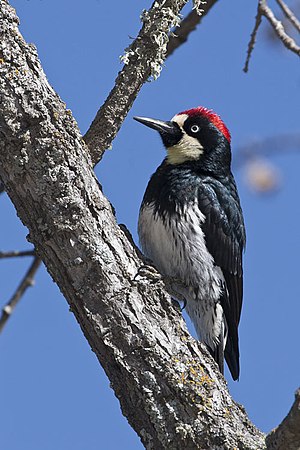Acorn woodpecker
Acorn woodpeckers (Melanerpes formicivorus) live in groups of up to 15 adults who defend each others' food and raise each others' children. Because their food source, acorns, are only available in warmer parts of the year, the woodpeckers store extra acorns for the winter in "granaries," each comprised of thousands of holes that the birds have drilled into a tree or another wooden structure. Building a granary requires a lot of labor, and so does guarding it. So, these American woodpeckers help each other out through by living and working communal. Adults raise each others' children, and birds who do not breed will stay at their parents' nest in order to help raise their younger siblings.[1]
In 1925, the scientist Frank Leach wrote a paper "Communism in the California woodpecker." In it, Leach described how the woodpeckers took shifts incubating eggs.
From all appearances incubation was carried on by relays. Upon arrival of one bird at the entrance of the nest, the one already there would come out and fly away. Thereupon the new arrival would enter and remain until relieved. At no time did a bird come out before the arrival of a relay. The time of duty on the nest varied from five to fifteen minutes.[2]
A century of field studies has confirmed Leach's observation that the woodpeckers live communally and cooperate for survival. A 2017 Forbes headline said, "Long-Term Field Studies Explain Why These American Woodpeckers are Communists."[3]
- ↑ GrrlScientist, "Long-Term Field Studies Explain Why These American Woodpeckers are Communists," Forbes, 18 October 2017, https://www.forbes.com/sites/grrlscientist/2017/10/18/long-term-field-studies-explain-why-these-american-woodpeckers-are-communists/#b978daf30326.
- ↑ Frank A. Leach, "Communism in the California woodpecker," The Condor, 27, no. 1 (1925):12-19, https://sora.unm.edu/sites/default/files/journals/condor/v027n01/p0012-p0019.pdf.
- ↑ GrrlScientist, "Long-Term Field Studies."
